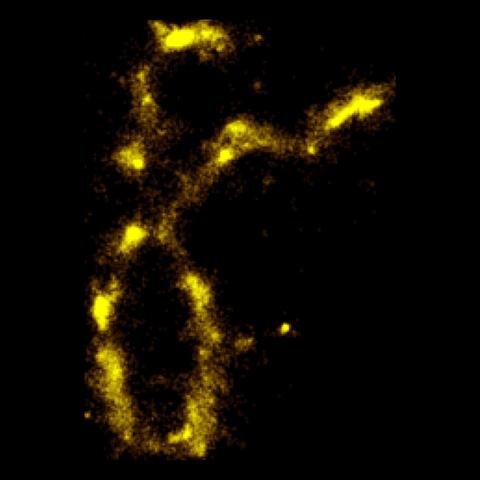At first, Meredith Yeager, Ph.D., thought there was a mistake in the data.
She was examining the association between exposure to ionizing radiation after the 1986 Chernobyl power plant disaster and the frequency of exposed Ukrainians later passing radiation-driven genetic mutations to their children. Previous studies suggested that the children’s DNA should have contained multiple such mutations. It didn’t.
“Any weird thing I see, I always assume that I messed something up,” said Yeager, director of the Cancer Genomics Research Laboratory at the Frederick National Laboratory.
She explained that attributing anomalies and potential mistakes to human error prevents odd-looking data from being accepted until it can be verified. Another part of the data verified it: the child’s number of other mutations was correlated with the parents’ age—especially the father’s age—at the time of the child’s conception, a “normal” and already well-understood genetic phenomenon unrelated to the radiation. It was exactly what was expected if the data were correct.
There was no mistake. People exposed to moderate ionizing radiation long-term do not pass additional mutations to their future children.
The findings appeared in one of two Chernobyl-focused studies, led by the National Cancer Institute’s Division of Cancer Epidemiology and Genetics, that appeared in Science online in April. Media outlets, including Science News, BBC, Wired, and National Geographic, picked up the results and spread them to an international audience.
Decades-Long Relationships Underpin a ‘Once-in-a-lifetime Project’
Yeager, a geneticist, was co-first author on the paper alongside Mitch Machiela, Ph.D., a tenure-track epidemiologist at NCI.
“This was an exciting analysis, as we did not know what the relationship would be between ionizing radiation and de novo mutations [‘new’ mutations passed from parent to child] before the analysis,” Machiela said. “This was a very exciting finding!”
It also diminishes the decades-long atomic-era fear that ionizing radiation can have multigenerational effects. The findings offer a sense of relief to people concerned about passing along mutations after exposure during events like Chernobyl, the 1945 bombings of Hiroshima and Nagasaki, and the 2011 Fukushima Daiichi power plant accident.
Decades of work and international partnerships converged around the study. Teams at Ukrainian and Russian institutions have been collecting genetic samples and exposure data almost since the 1986 incident, partnering with NCI to analyze various effects and connections with cancer. Meanwhile, the Cancer Genomics Research Laboratory works closely with NCI’s Division of Cancer Epidemiology and Genetics. The study’s team spanned five countries across four continents.
“I loved working with the team. I’ve worked with these same people … or many of the other people on the paper for years and years, if not decades,” Yeager said. “I guess if you stay somewhere long enough, then you basically know everyone, and sometimes you get to do these once-in-a-lifetime projects.”
Machiela is similarly enthused, citing “team science” like the collaboration as what makes large studies possible.
“I enjoy working with a multidisciplinary team that included dosimetrists, geneticists, and epidemiologists, where each member contributes their expertise to tackle a very interesting scientific question of great importance to Chernobyl residents as well as other populations exposed to ionizing radiation,” he said.
Latitude for Learning and Discovery
The unification of different expertise and the sharing of information created a rich research environment. Team members could educate themselves and excel at their strengths as they worked. Both Machiela and Yeager immersed themselves in the data and its accompanying concepts.
“My favorite part about working on this project was the opportunity to learn about a new exposure (ionizing radiation) and outcome (de novo mutations). These are two areas I knew limited [sic] about prior to my work on these studies,” said Machiela, who performed the in-depth statistical analyses.
Yeager handled most of the genetic analyses herself, a rare opportunity for her and a pleasant return to her scientific roots. (The highlight of her early career was detailed studies of immune system genes.) Other colleagues managed adjacent areas of the project. Shulabh Suman, Ph.D., in the Cancer Genomics Research Laboratory aligned and called the data, while Prachi Kothiyal, Ph.D., at NCI worked with Yeager to fine-tune the analytical algorithms.
“It was fun, and I learned a lot, and I thought a lot about it,” Yeager said.
Partnerships and the research environment put the team in a sound position to obtain meaningful results, and technology sealed the deal. Platforms and software for genetic sequencing and analysis—methods for analyzing DNA—have exploded over the last several years and become increasingly robust.
“This was a question that predated the Human Genome Project. With drastic reductions in sequencing costs that enabled this data to be generated, it was now possible to more comprehensively address this question,” Machiela said.
Thanks to an adept fusion of collaboration, expertise, and scientific advances, that looming question of radiation now has an answer—and it happens to be good news.
It’s a best-case scenario: team science at its finest, with firmly encouraging findings to boot.
Samuel Lopez is a technical editor in Scientific Publications, Graphics & Media (SPGM), where he writes for NCI at Frederick and Frederick National Laboratory’s news outlets; manages the day-to-day operations of the Poster newsletter; informally serves as an institutional historian; and edits scientific manuscripts, corporate documentation, and a slew of other written media. SPGM is the facilities’ creative services department and hub for editing, illustration, graphic design, formatting, and multimedia training and support.


